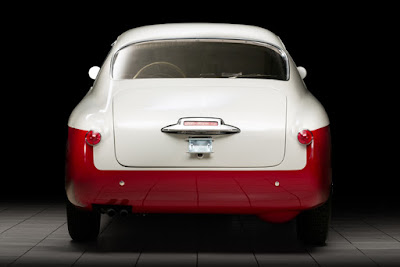 |
| One of The Alfatross' siblings with the original front bumper. |
Having previously posted on the importance of styling (“form”) this one is about the compromises imposed by “function”. I made the decision a long time ago (Posts 38 and 41) to delete the bumpers on The Alfatross. My reasoning was (a) these cars look better without bumpers, particularly the one in front and (b) The Alfatross did not have its original bumpers anyway when I got it so restoration was never an option, only replication.
 |
| The Alfatross, sans bumpers. |
 |
| Another sibling with deleted rear bumper and sockets |
The designer of the Alfa 1900C SSZ, Elio Zagato, realizing bumpers are a compromise between form and function, made them as unobtrusive as possible but—at least in my eye—they still mar the car’s lines. Apparently other people agree. The vast majority of The Alfatross’ siblings no longer have them, their original bumpers having been removed long ago, like “docking” the tails of Dobermans at an early age. I count 7 with and 23 without, but a few have “sockets” in the bodywork so that bumpers can be reattached depending on the occasion.
Cars have bumpers for a reason. Actually, many reasons. They were a part of every car’s essential equipment almost from the beginning (1897). The challenge for designers and builders was to make them attractive as well as functional. Having OD’d on massive chrome extravagances in the 50s, designers began to realize that smaller, lighter, less ostentatious bumpers are both more practical and sensible. Besides, the world was running out of chrome!
 |
| 1957 Thunderbird: every sports car needs a 200 lb bumper! |
 |
| Look Ma! No bumpers! Elio would be proud! |
Then, safety regulators and insurance companies got involved and bumpers started to disappear in the 1980s, or rather morph into energy-absorbing structures hidden behind flimsy plastic bumper covers conforming to body shape. So now bumpers on The Alfatross’ descendants, like the Alfa 4C, are present, but invisible—the best of both worlds.
What I have discovered is that The Alfatross may look better without its bumpers, but now there is no handy place to tie the car down, push it, tow it, or even hang the original Italian front license plate!
That is a realization I came to recently due to considerations pertaining to getting the car on the road. In a recent Sports Car Market Reader Forum the question readers were asked to address was “What one thing are you most concerned about when you think about taking your collector car out of the garage?”
Responses varied including safety, inattentive other drivers, putting miles on the odometer, wear and tear, etc., but by far the most common concern was reliability and breakdowns. This is one of my biggest concerns for The Alfatross right now as we get ready for road-testing without bumpers. For trailering, the car can be secured using ratcheting “bonnets” over the tires attached to tracks fixed to the trailer’s floor, but what if something goes wrong on a drive and I can’t get the Alfatross home under her own power?
Because this was not one of the concerns expressed in the Reader Forum now I am wondering if I am too paranoid (a little paranoia is a good thing). The normal recourse would be to call for a piggyback ride aboard a flatbed tow truck. Unfortunately, that won’t work for The Alfatross because the chassis is low anyway and the body wraps under the car front and rear—by several feet—and will be damaged if winched by a cable at anything more than a very low angle!
 |
| Yeah, but what is there to tie onto? Run the ropes through the open windows? |
Oh the joys of old Italian exotic car ownership! How much can a Chinook lift and what do they charge to rescue a damsel in distress?




